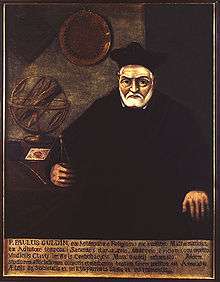Paul Guldin
| Paul Guldin | |
|---|---|
 Paul Guldin | |
| Born | June 12, 1577 |
| Died | November 3, 1643 (aged 66) |
| Nationality | Swiss |
| Other names | Habakkuk Guldin |
| Occupation |
Jesuit mathematician astronomer |
| Known for | Guldinus theorem |
Paul Guldin (original name Habakkuk Guldin) (June 12, 1577 (Mels) – November 3, 1643 (Graz)) was a Swiss Jesuit mathematician and astronomer. He discovered the Guldinus theorem to determine the surface and the volume of a solid of revolution. (This theorem is also known as the Pappus–Guldinus theorem and Pappus's centroid theorem, attributed to Pappus of Alexandria.) Guldin was noted for his association with the German mathematician and astronomer Johannes Kepler.[1] Guldin composed a critique of Cavalieri's method of Indivisibles.[2]
He was born in Mels, Switzerland and was a professor of mathematics in Graz and Vienna.
In Paolo Casati's astronomical work Terra machinis mota (1658), Casati imagines a dialogue between Guldin, Galileo, and Marin Mersenne on various intellectual problems of cosmology, geography, astronomy and geodesy.
See also
Notes
- ↑ Kepler's relation to the Jesuits—A study of his correspondence with Paul Guldin, by Georg Schuppener, NTM Zeitschrift für Geschichte der Wissenschaften, Technik und Medizin, Sunday, June 01, 2008
- ↑ Amir Alexander (2014). Infinitesimal: How a Dangerous Mathematical Theory Shaped the Modern World. Scientific American / Farrar, Straus and Giroux. ISBN 978-0374176815.